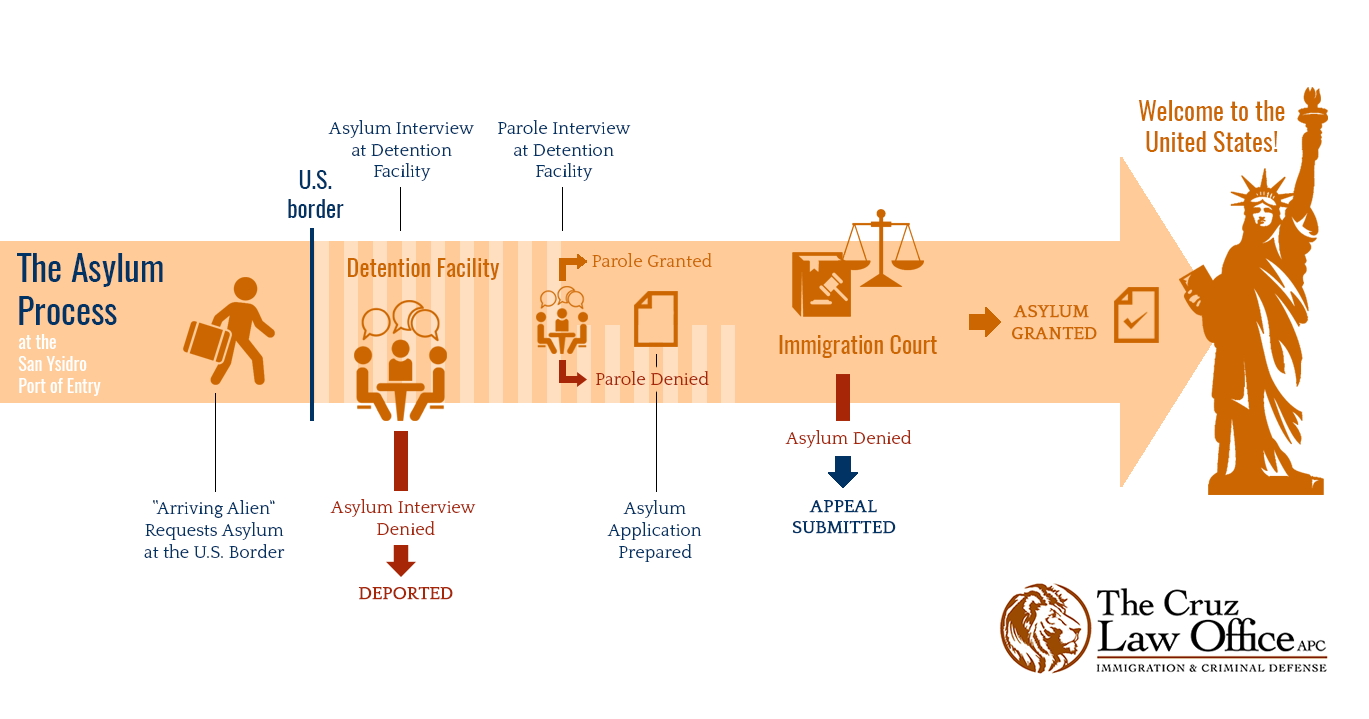Seeking Asylum in the United States: Detention at San Ysidro Port of Entry

As an immigration attorney in San Diego, California, I received many calls and inquiries related to family, friends and loved ones who are in detention at San Ysidro Port of Entry. Many of them are seeking refuge in the United States to escape persecution from their governments, extortion from gangs and other criminal organizations, domestic violence from their partners, and/or any other form of tortured in their home country.
In recent times, and due to their proximity to the United States, many asylum seekers come from countries like Mexico, El Salvador, Guatemala, Honduras, Peru, and Colombia, where corruption and violence have forced many out of their home country. However, there are still many others who come from places as far as Africa, Eastern Europe, the Middle East, and Asia.
The graphic above shows the asylum process from the moment an individual renders themselves at the San Ysidro Port of Entry to seek Asylum in the U.S.
Below, I will try to answer some of the most common questions:
What happens when you are in detention at San Ysidro Port of Entry if you have rendered yourself to seek asylum?
United States Customs and Border Protection Officers (USCBP) are trained to screen individuals afraid of returning to their country of origin. Therefore, if a person expresses or indicates fear of returning to his country of origin, that person is separated and placed in custody at the port of entry.
Once the person is initially screened, he will be held at the port of entry, so that immigration can move him to a more permanent detention facility, equipped with bed space, phone privileges, and visitation access for family and legal representatives. However, the duration of this initial detention can vary from as little as one or two days to as much as ten to fifteen days. In rare occasions, a person can be detained even longer.
Normally, Immigration determines where to house the individual detained that is detained at the port of entry depending on the availability of bed space in detention facilities. For that reason, an individual that crosses near San Diego can end up detained at a facility far away from San Diego.
Once the asylum seeker is processed and moved from the San Ysidro Port of Entry to a detention facility, that person will be given an interview with an asylum officer. The purpose of the interview is to assess whether the individuals initially qualifies to seek asylum before an immigration judge.
There is no exact time that an individual will wait in order to get an asylum interview. Sometimes it can be a matter of days and other times it can take months. Many variables come into play for the delay of an asylum interview, such as the location of the detention center where the individual is housed, the availability of the asylum officers that have jurisdiction over the individual, and the number of people also detained and waiting for their asylum interview.
What is the asylum process like when someone is in detention at San Ysidro Port of Entry?
When a person seeks asylum at the San Ysidro Port of Entry, the individual may be detained with immigration until given an asylum interview (also known as a credible fear interview or reasonable fear interview).
This process can take several weeks or even months. If USCBP decides to maintain the individual in custody, he or she may be moved to an immigration detention facility to wait the asylum interview.
The asylum interview is usually takes one or two hours, but sometimes it can take longer. During that process, the asylum seeker will be afforded an interpreter to communicate with the asylum officer.
The purpose of the asylum interview is to conduct a preliminary screening to determine if the individual detained has sufficient basis to present a full asylum claim before an immigration judge. If the asylum officer renders a positive decision, the asylum seeker will be given the opportunity to present his case before an immigration judge.
For an individual who is detained, a positive decision by an asylum officer means that the individual can seek to be released on parole and check out of the immigration detention center. If parole is denied, the asylum seeker will remain in immigration custody while fighting the asylum claim.
What is immigration looking for during an asylum interview when in detention at San Ysidro Port of Entry?
The immigration statute defines a refugee as “any person who is unable or unwilling to return to his or her country because of persecution, a well-founded fear of persecution on account of race, religion, nationality, membership in a particular social group, or political opinion.”
Below is a statement read to the asylum seeker at the beginning of the asylum interview:
“The purpose of this interview is to determine whether you may be eligible for asylum or protection from removal to a country where you fear persecution or torture. I am going to ask you questions about why you fear returning to your country or any other country you may be removed to. It is very important that you tell the truth during the interview and that you respond to all of my questions.
This may be your only opportunity to give such information. Please feel comfortable telling me why you fear harm. U.S. law has strict rules to prevent the disclosure of what you tell me today about the reasons why you fear harm. The information you tell me about the reasons for your fear will not be disclosed to your government, except in exceptional circumstances.
The statements you make today may be used in deciding your claim and in any future immigration proceedings. It is important that we understand each other. At any time I make a statement you do not understand tell me so that I can explain it to you. At any time you tell me something I do not understand, I will ask you to explain.”
What if I don’t have any evidence at my asylum interview to support my claim?
In asylum proceedings, the person applying for the benefit has the “burden of proof,” that is, that person must convince the Immigration Judge that he or she is deserving of the benefit.
The positive testimony of a person is said to be enough to satisfy this burden; however, the more evidence you have to prove your claim the better.
A lot of things can be included as evidence; e.g. police reports, hospital reports, testimonies of friends and family members, publications, letters, and news.
If I am detained, when should I get the results of my asylum interview?
Realistically, you will be notified of the result of your asylum interview one to three weeks after your interview.
The time it takes to evaluate your asylum interview and to decide whether you “pass” depends on different factors. Decision times may vary depending on the detention facility, how many asylum officers are available at the detention facility, and how many other asylum interviews are being handled.
What happens if I get denied (a negative determination) at my asylum interview?
If you receive a negative decision, you can still request a review of the negative determination by an Immigration Judge. If you decide not to request a review, you will be removed from the U.S. You will also be removed if you request a review but the Immigration Judge confirms the negative decision.
You have limited rights when an immigration judge reviews your case. You can have an immigration attorney consult you but cannot have an attorney represent you before the immigration court.
An attorney, however, can assist you by communicating with USCIS. Your attorney can attempt to convince the asylum office that you should be re-interviewed because of a procedural error such as an error by the interpreter or a material misunderstanding.
What is the immigration parole process like?
After you have “passed” your asylum interview you may be eligible for parole and be released from the detention facility. Parole is at the discretion of the enforcement removal officer (ERO) and determined at a parole interview. ICE will give you a notification that states when you have to appear for you parole interview. To “pass” the parole interview you may present the following:
-
Who you are
You can prove your identity with your passport, birth certificate, or, if both are unavailable, with sworn statements by your relatives or other people who know you.
-
Why you are likely to appear to all scheduled court hearings
You should provide evidence of your close ties to a community in the U.S. and, if possible, a letter from a friend or family who will let you live with them with all relevant information about them. Names and addresses of friends and family in the U.S. or organizations such as religious groups you have ties to may also be helpful.
-
Why you do not present a danger to the U.S. or the community
ICE will evaluate your criminal history. If your criminal history is an argument against you, you should provide evidence of how you changed your life since the incident(s) and why you will not present a danger in the future.
After your parole interview, you will be notified by ICE about their decision within 7 days. If you are denied parole ICE will include the reason for their decision. In this case, you can request ICE to review the decision.
How can I know if my loved one will get parole from an immigration detention center?
Whether your loved one who is applying for asylum in the U.S. can get paroled from the immigration detention center depends on the asylum interview and the parole interview. At first, an immigration officer will determine during the asylum interview whether your loved one’s asylum application is based on a “well-founded” fear. If the immigration officer finds this is the case, your loved one may proceed with the asylum application and may be eligible for parole while waiting to present the case in front of an immigration judge. After that, your loved one will have the chance to present his or her case during the parole interview. If the officer then determines that your loved one established his or her identity, is likely to appear to all scheduled court meetings, and not likely to present a danger to the community, he or she will be granted parole. Therefore, you cannot know for certain whether your loved one will get parole before both interviews take place, but if you think your loved one meets the above requirements, it is likely that they will get parole.
Legal Disclaimer: Nothing in this website should be taken as legal advice for an individual case or situation. The information is intended to be general and should not be relied upon for any specific situation.
Contact The Cruz Law Office now for more information about what to do when at detention at San Ysidro Port of Entry.



